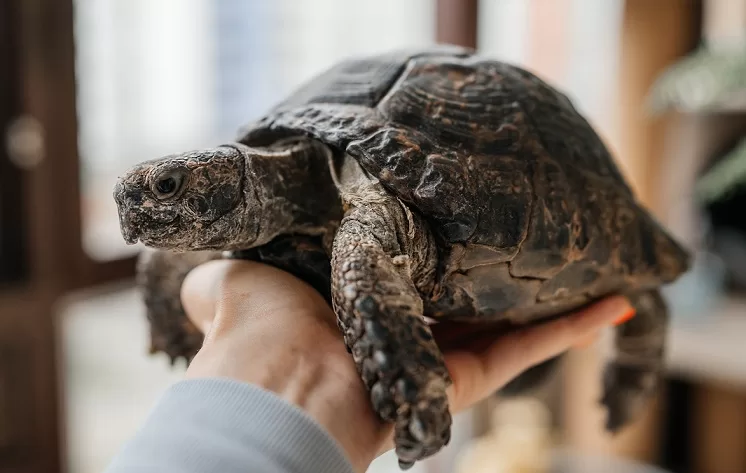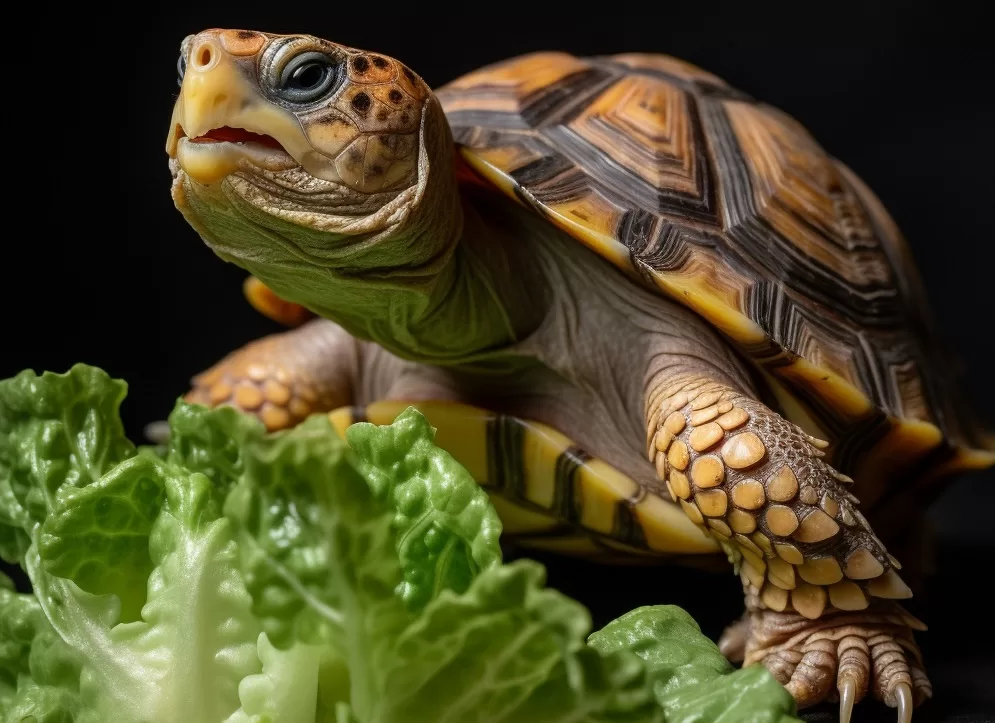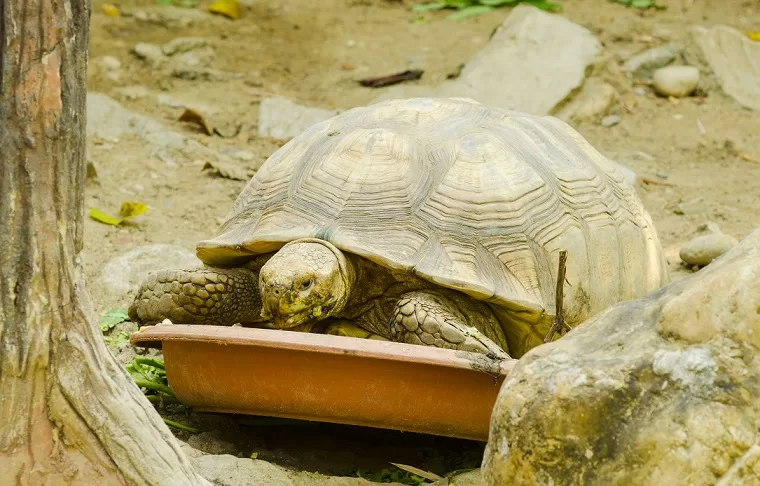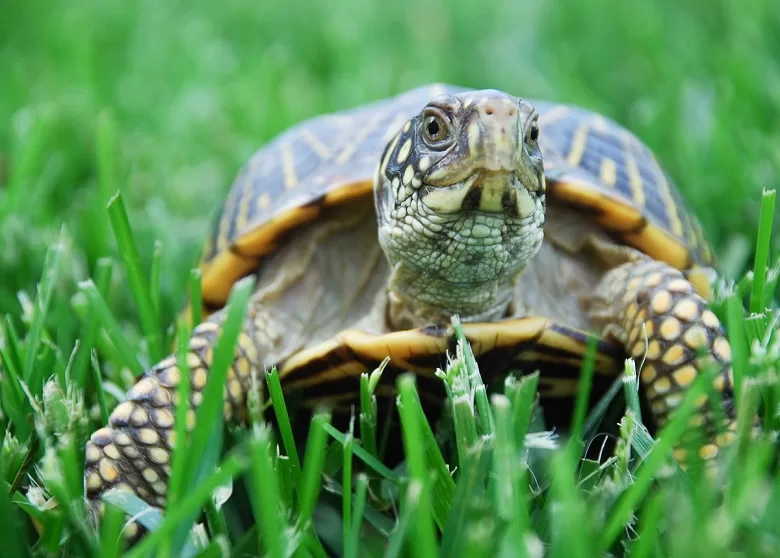Are you considering a new addition to your family in the form of a pet turtle? If so, you’ve come to the right place! In this comprehensive guide, we will explore everything you need to know about raising a happy and healthy pet turtle, from choosing the right species to providing proper nutrition and habitat. Let’s dive in!
10 Types of Turtles That Make Great Pets
- Red-Eared Slider
- African Sideneck Turtle
- Easter Box Turtle
- Western Painted Turtle
- Mississippi Map Turtle
- Common Musk Turtle (Stinkpot)
- Spotted Turtle
- Yellow-Bellied Slider
- Reeve’s Turtle
- Wood Turtle

Thinking of getting a pet turtle?
Before you commit to a pet turtle, it’s essential to be aware of some crucial factors. Turtles can carry salmonella, so proper hygiene is a must. Selling small turtles is illegal in some places, and larger turtles will need a lifetime of specialized care. Furthermore, they should never be released into the wild.
Getting a Pet Turtle
Before You Do Anything
Do thorough research on the specific species you’re interested in, as their care requirements can vary significantly. Keep in mind that turtles can have long lifespans, so you’re making a long-term commitment.
Life Span
Turtles are known for their longevity, with some species living for several decades. Make sure you’re prepared for this commitment before adopting a turtle.
Enclosure Requirements
Each species of turtle will have its own enclosure requirements. Aquatic turtles need ample swimming space, while terrestrial turtles require a spacious, large enclosure with hiding spots and suitable substrate.
Best Beginner Pet Turtles and Tortoises
Best Beginner Turtles
- Red-Eared Slider
- Box Turtle
- Razor-backed Musk Turtle
- Painted Turtle
Best Beginner Tortoises
- Russian Tortoise
- Greek Tortoise
- Red-footed Tortoise
- Yellow-footed Tortoise

9 Things to Know Before Adopting a Turtle
Not All Turtles Swim: While many turtles, like the Red-Eared Slider, are adept swimmers, other turtles, like the Eastern Box Turtle, are primarily terrestrial and prefer land-based habitats. Make sure to understand the specific needs of the species you’re considering before adopting.
Turtles Are Long Lived: Some turtle species can live for several decades, making them a long-term commitment. For example, a well-cared-for Red-Eared Slider can live up to 30 years, so be prepared for the responsibility.
All Turtles Carry Salmonella: Turtles can carry salmonella bacteria on their shells and skin, posing a risk to humans. Always wash your hands thoroughly after handling your turtle or cleaning its habitat to minimize the risk of infection.
You Can Tell Boy and Girl Turtles Apart: In many species, males have longer tails and more curved plastrons (the bottom part of the shell) than females. For example, male Red-Eared Sliders typically have longer claws than their female counterparts.
Females Can Lay Eggs Without Males: Even without mating, female turtles can lay infertile eggs. If your female turtle starts exhibiting nesting behavior, like digging or becoming restless, provide her with a suitable nesting site.
Aquatic Turtles Still Need Dry Land: Aquatic turtles, like the Painted Turtle, need a dry basking area where they can rest, warm up, and regulate their body temperature. Provide a platform or ramp that allows easy access to the basking area.
Even Tiny Turtles Need Big Spaces: Small turtles, such as the Mississippi Map Turtle, still require ample space to swim, explore, and bask. A 55-gallon tank is often the minimum recommended size for an adult aquatic turtle.
Turtles Need Veggies, Too: Turtles require a varied diet that includes vegetables and leafy greens. For example, a Russian Tortoise’s diet should consist of 80-90% leafy greens, such as collard greens, dandelion greens, and endive.
Turtles Know Their Owners!: While turtles may not be as social as dogs or cats, they can recognize and form bonds with their owners. A Red-Eared Slider owner named Lisa noticed her turtle would swim towards her whenever she approached the tank, indicating a recognition of her presence.
Caring for Your Turtle
Choosing the Right Species of Turtle
When selecting a turtle species, consider factors such as size, lifespan, and habitat requirements. Consult with experienced owners or a veterinarian specializing in reptiles for advice on the best species for your lifestyle.
Setting up an Appropriate Habitat
For aquatic turtles, you’ll need a tank large enough for them to swim comfortably, a basking site, a water filter, and a heat/light source. Terrestrial turtles need a spacious enclosure with appropriate substrate, hiding spots, and a basking area. Enrichment, such as rocks and plants, can help keep your turtle engaged and happy.
Feeding Requirements and Nutrition
A balanced diet is critical for your turtle’s health. Aquatic turtles will typically eat a mix of commercial turtle pellets, insects, and leafy greens. Terrestrial turtles, like tortoises, will have a more herbivorous diet, primarily consisting of leafy greens, vegetables, and occasional fruits. Consult with a veterinarian to ensure your turtle’s dietary needs are being met.

What does a pet turtle eat?
A balanced and varied diet is crucial for your pet turtle’s health and well-being. Different species have different dietary requirements, but the following list provides a general overview of the types of foods commonly fed to them.
Leafy greens: Nutritious leafy greens like dandelion greens, collard greens, mustard greens, and kale should form a significant part of your turtle’s diet. For example, a Russian Tortoise’s diet should consist of 80-90% leafy greens. Be sure to avoid lettuce, as it lacks the necessary nutrients and can cause digestive issues.
Vegetables: Vegetables such as carrots, bell peppers, zucchini, and squash are a great source of vitamins and minerals for your turtle. For instance, you can offer chopped vegetables to an Eastern Box Turtle a few times a week.
Fruits: Fruits like strawberries, blueberries, and apples can be given to your turtle as occasional treats. It’s important to limit the amount of fruit in your turtle’s diet, as too much sugar can lead to health issues. A small piece of fruit once a week is a suitable treat for a Painted Turtle.
Aquatic plants: Aquatic turtles, like the Red-Eared Slider, will benefit from having live aquatic plants in their tank, such as Anacharis and Duckweed. These plants can provide additional nutrients and a natural food source for your turtle.
Protein: Many turtle species require protein in their diet. Sources of protein for turtles include insects like crickets, mealworms, and earthworms, as well as small fish/dried shrimp (for aquatic turtles) and commercial turtle pellets. For example, a young Red-Eared Slider’s diet should consist of roughly 50% protein, which can be provided through a combination of live prey and high-quality turtle pellets.
Calcium supplements: To support healthy shell growth and prevent metabolic bone disease, turtles need calcium in their diet. Sprinkle calcium powder (preferably with added vitamin D3) on your turtle’s food a couple of times a week or provide a cuttlebone in their enclosure as a calcium source.Regular check-ups with a reptile specialist veterinarian are essential for maintaining your turtle’s health. Common health issues in turtles include shell rot, respiratory infections, and parasites. Keep an eye out for any changes in behavior or appearance, and seek veterinary care if you notice anything unusual.
Socializing and Handling Your Pet Turtle
While turtles may not be as social as other pets, they can still recognize their owners and form bonds with them. Handle your turtle gently and with clean hands to minimize the risk of spreading salmonella. Limit handling to short periods to avoid stressing your turtle. Regular interaction can help your turtle become more comfortable with you, making routine care and check-ups easier.
Unique Aspects of Owning a Pet Turtle
Do Your Research
Before adopting a turtle, thoroughly research the specific needs of the species you’re interested in. Join online forums, read books, and consult with professionals to ensure you’re fully prepared to provide the best care possible.
What Is the Difference Between a Turtle and a Tortoise?
While both turtles and tortoises are reptiles belonging to the order Testudines, they have distinct differences. Turtles typically have a more streamlined shell and are adapted for aquatic or semi-aquatic environments, while tortoises are strictly land-dwelling and have a more domed shell. Their diets and habitat requirements will also differ.

Turtles vs. Tortoises as Pets
When deciding between a turtle and a tortoise, consider your living situation and the level of care you’re able to provide. Tortoises generally require a more spacious terrestrial enclosure and a primarily herbivorous diet, while turtles need an aquatic setup with a balanced diet of protein, leafy greens, and pellets.
Common Types of Pet Turtles and How to Care for Them
Types
There are several turtle species suitable for beginners, including Red-Eared Sliders, Box Turtles, and Painted Turtles. Each species will have its own specific care requirements, so it’s crucial to familiarize yourself with the needs of the turtle you plan to adopt.
Turtles you shouldn’t have as pets
Some turtle species are endangered, illegal to own, or have extremely specialized care requirements. Avoid adopting turtles like the Alligator Snapping Turtle, Sea Turtles, or Diamondback Terrapins as pets.
What you need to take care of pet turtles
Essential items for pet turtle care include:
A tank or enclosure of appropriate size: The size of the tank or enclosure will depend on the species and size of your turtle. For example, an adult Red-Eared Slider will require at least a 75-gallon tank or larger, while a smaller Eastern Box Turtle can be housed in a 40-gallon terrarium. Always ensure the enclosure is spacious enough for your turtle to comfortably move around, swim, and explore.
A light/heat source: Turtles need a heat source to regulate their body temperature. For aquatic turtles, a heat lamp should be placed above the basking spot to create a warm spot. For terrestrial turtles, a temperature gradient should be maintained in the enclosure using a lamp or under-tank heater. In both cases, a UVB light is also necessary for proper calcium absorption and overall health.
A basking site: Aquatic turtles need a dry basking area where they can rest and warm up under the heat lamp. This can be achieved using a floating dock or a large, flat rock that is easily accessible from the water. Terrestrial turtles will also benefit from a designated area within their enclosure.
A water filter (for aquatic turtles): A high-quality water filter is essential for maintaining clean and healthy water. Filters help remove waste, debris, and harmful chemicals from the water, reducing the risk of illness. For example, a canister filter designed for aquariums is suitable for a Red-Eared Slider’s tank.
Enrichment items, such as rocks and plants: Providing enrichment in your turtle’s environment encourages mental stimulation and natural behaviors. Add rocks, logs, and live or artificial plants to create a more engaging habitat. For instance, placing a few large rocks in an aquatic turtle’s tank can create hiding spots and resting areas, while adding artificial plants to a terrestrial turtle’s enclosure can simulate their natural environment.

Additional Tips for Raising a Happy and Healthy Pet Turtle
Regularly Clean the Habitat
Maintaining a clean environment is crucial for your turtle’s health. For aquatic turtles, invest in a high-quality water filter and perform regular water changes to keep the water clean. Terrestrial turtles also require regular habitat cleaning to remove waste and prevent bacterial growth.
Monitor Temperature and Humidity
Turtles are ectothermic, meaning they rely on external sources of heat to regulate their body temperature. Aquatic turtles require a place to bask with a heat lamp to warm up, while terrestrial turtles need a temperature gradient in their enclosure. Use a thermometer to monitor the temperature, and adjust the heat source as needed. Also, maintain proper humidity levels to keep your turtle comfortable and stay healthy.
Provide UV Lighting
Turtles need exposure to ultraviolet (UV) light to properly synthesize vitamin D3, which is necessary for calcium absorption and healthy shell development. Make sure to provide your turtle with a UVB light source and replace the bulb according to the manufacturer’s recommendations.
Trim Your Turtle’s Nails
Overgrown nails can be uncomfortable and even painful for your turtle. Regularly inspect your turtle’s nails, and if they become too long, carefully trim them using a reptile nail clipper or consult with a veterinarian for assistance.
Trim Your Turtle’s Beak
An overgrown beak can cause discomfort and difficulty eating for your turtle. Regularly check your turtle’s beak, and if it becomes too long or misshapen, carefully trim it using a reptile-safe file or consult with a veterinarian for assistance. Just like with nail care, proper beak maintenance is essential for your turtle’s overall health and well-being.
Create a Varied Diet
Offering a varied diet can help prevent boredom and ensure your turtle receives all the necessary nutrients. Rotate between different types of leafy greens, vegetables, fruits, and protein sources to provide a balanced and exciting diet.
Enrichment Activities
Providing enrichment for your turtle can stimulate their mind and prevent boredom. Introduce items such as caves, logs, and live or artificial plants to create an engaging environment. You can also offer food in creative ways, such as hiding it in a puzzle feeder or floating it on a leaf to encourage foraging.
Educate Yourself on Potential Health Issues
Understanding common health issues in turtles can help you identify problems early and seek prompt treatment. Some health concerns to be aware of include metabolic bone disease, vitamin A deficiency, and shell rot. Regular veterinary check-ups can help catch and address issues early on.
Be Prepared for Your Turtle’s Growth
As your turtle grows, its habitat and care requirements may change. Be prepared to upgrade its enclosure and adjust the diet as needed to accommodate its growth.
Join a Community of Turtle Enthusiasts
Connecting with other turtle owners can provide invaluable support, advice, and camaraderie. Join online forums, social media groups, or local clubs to share experiences and learn from others who share your passion for turtles.
By following these tips and regularly consulting with a veterinarian or experienced turtle, you’ll ensure your pet thrives in your care. Enjoy the rewarding experience of raising a pet turtle and providing it with a happy and healthy life!

A Pet Turtle Can Change Your Life
Let us tell you a really heart-warming story about a friend of ours named Tom…
When Tom and his family adopted Squirt, a tiny Red-Eared Slider, they had no idea how much joy this little creature would bring into their lives. As Squirt grew, so did his personality. He would spend his days basking under the heat lamp, eagerly swimming towards the glass when Tom approached with a delicious mix of leafy greens and tiny turtle pellets. Tom was captivated by the intricate patterns on Squirt’s shell and would often share pictures with friends and family, inspiring curiosity about these amazing reptiles.
As Squirt became more comfortable in his new home, Tom learned just how intelligent turtles could be. Squirt quickly recognized Tom’s presence, extending his neck towards him, anticipating mealtime. Tom couldn’t help but feel a sense of pride in his pet turtle’s unique abilities and the special bond they shared.
Squirt’s arrival sparked a newfound passion for turtle care in Tom and his family, leading them to join local turtle clubs, attend reptile expos, and even volunteer at turtle rescue centers. The experience of raising Squirt opened their eyes to the joys and responsibilities of keeping a pet turtle, and they couldn’t be happier with their decision.
If you’re considering bringing one into your home, this comprehensive guide will provide you with all the necessary information to ensure a happy and healthy life for your new shelled friend. From choosing the right species to setting up an appropriate habitat, we’ll cover everything you need to know to embark on your turtle-keeping journey.
Tom and his family’s story serves as a wonderful example of the joy and fulfillment that these unique pets can bring into our lives. With proper care and attention, Squirt has grown into a healthy and content turtle, teaching Tom and his family the importance of being aresponsible pet owner.
Raising one is undoubtedly a rewarding experience, but it also comes with its share of challenges and responsibilities. By following the advice provided in this guide, you’ll be well-equipped to embark on your turtle-keeping journey, creating a nurturing environment where your shelled companion can thrive.
FAQ
Q: How much does it cost to have a pet turtle?
A: The initial cost of setting up a proper turtle habitat, including a tank or enclosure, heat and UVB lamps, filter, and accessories, can range from $200 to $500 at pet stores, depending on the species and size of the turtle. Ongoing costs for food, electricity, and maintenance can add another $10 to $30 per month. Additionally, consider potential costs for veterinary care, which can vary depending on the turtle’s health and location.
Q: What is the easiest pet turtle or tortoise?
A: Some of the easiest pet turtles for beginners include the Red-Eared Slider, Eastern Box Turtle, and Painted Turtle. These species tend to be hardy and adaptable, making them suitable for novice owners. As for tortoises, the Russian Tortoise, Greek Tortoise, and Red-Footed Tortoise are considered beginner-friendly due to their manageable size and relatively simple care requirements.
Q: Can I touch my pet turtle? and How?
A: You can touch your pet turtle, but it’s essential to handle them gently and infrequently to minimize stress. To pick up a turtle, place one hand on either side of its shell, ensuring you have a firm but gentle grip. Support the turtle’s weight evenly and keep it close to the ground to prevent injury if it tries to escape. Always wash your hands thoroughly before and after handling your turtle to minimize the risk of spreading bacteria, such as salmonella.
Q: How often should I clean my turtle’s tank or enclosure?
A: Regular cleaning is vital for maintaining a healthy environment for your pet turtle. For aquatic turtles, the water should be partially changed every week, and the tank should receive a thorough cleaning, including the filter, at least once a month. For terrestrial turtles, spot clean the enclosure daily to remove waste and replace the substrate every 1 to 3 months, depending on the species and the cleanliness of the habitat.
Q: How can I tell if my turtle is sick?
A: Signs of illness in turtles may include lethargy, loss of appetite, difficulty breathing, swollen or sunken eyes, discharge from the nose or mouth, shell abnormalities, or changes in feces. If you notice any of these symptoms or suspect your turtle is unwell, consult a reptile veterinarian as soon as possible.
Q: Do turtles need a companion?
A: Most turtles are solitary by nature and do not require a companion to thrive. In some cases, housing multiple turtles together can lead to aggression or competition for resources. However, some species of, like the Reeve’s Turtle, can be kept in groups if provided with adequate space and resources. Always research the specific social needs of the species you plan to adopt before considering adding another turtle to the enclosure.

